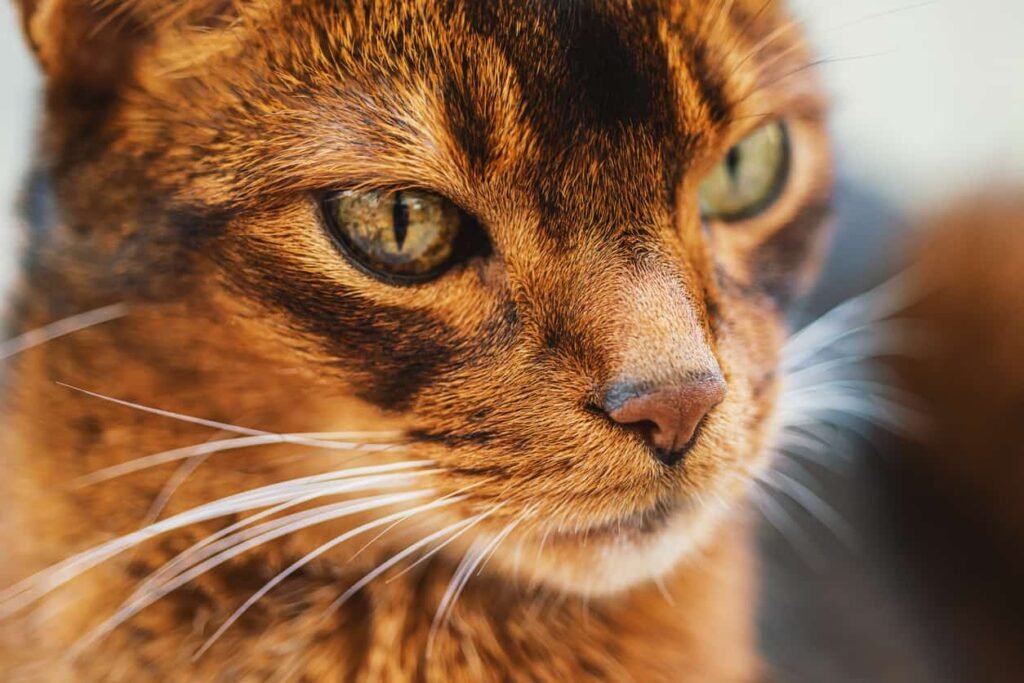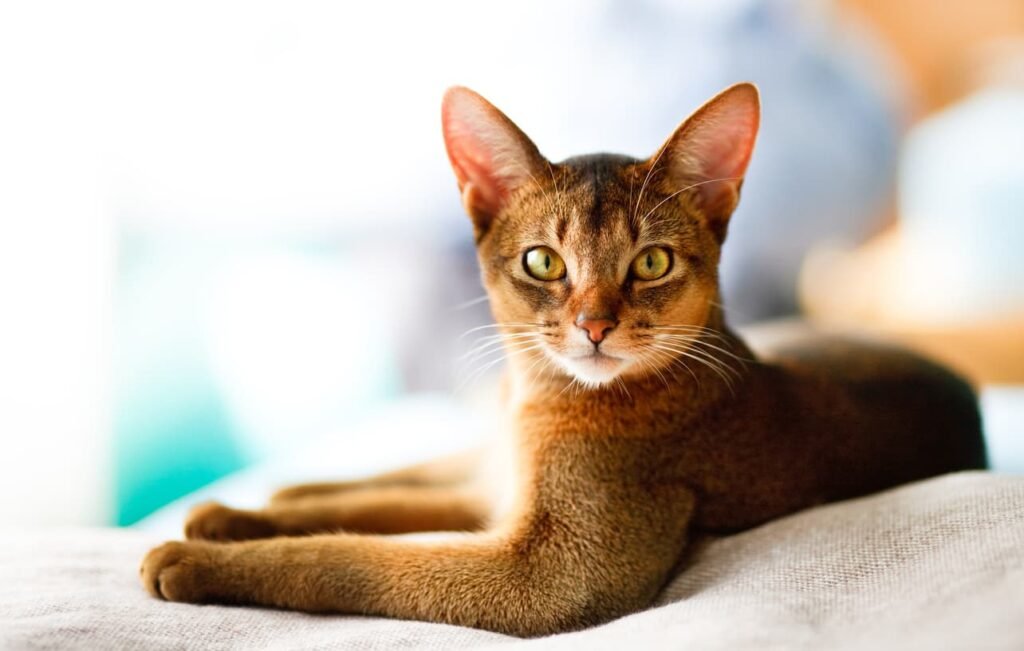The Abyssinian Cat is one of the oldest and most adored feline breeds in the world, celebrated for its striking appearance and engaging personality. Often referred to as the “Aby,” this breed captivates cat lovers with its slender, muscular body, large almond-shaped eyes, and ticked coat that seems to shimmer in the sunlight. Abyssinians are not only beautiful but also highly active and intelligent, making them excellent companions for individuals and families alike. Their playful, curious nature keeps them engaged with their environment, and their love for climbing and exploring is bound to delight owners.
Whether you’re thinking about adopting an Abyssinian or you’re simply interested in learning more about this ancient breed, this comprehensive guide will walk you through everything you need to know — from its history and physical characteristics to its personality, care needs, and more.
History and Origins
The Abyssinian Cat has a fascinating and somewhat mysterious origin. Although modern breeders often credit Ethiopia (formerly known as Abyssinia) as the birthplace of the Abyssinian breed, many cat experts suggest that its lineage traces back to ancient Egypt. Images and sculptures of cats resembling the Abyssinian have been found in Egyptian tombs, dating back thousands of years. These depictions show cats with the same graceful, slender bodies and alert ears that Abyssinians are known for today.
Another theory proposes that the breed originated along the coast of the Indian Ocean and Southeast Asia, where the wild cat species called the African Wildcat may have been domesticated. In the 1860s, it is believed that British soldiers returning from Abyssinia brought back a cat named Zula, which was bred to produce the modern Abyssinian breed in England.
Though their precise origins remain unclear, Abyssinians first gained significant popularity in Britain and later spread to the United States in the early 1900s. By the mid-20th century, the breed had become widely recognized in cat shows and had firmly established itself as one of the most beloved feline breeds worldwide.
Physical Characteristics of the Abyssinian Cat
The Abyssinian Cat is admired for its exotic, regal appearance. Their sleek, athletic bodies give them a distinctive appearance that makes them stand out among other breeds. Here’s a breakdown of the key physical characteristics:
Coat and Colors
The most defining feature of the Abyssinian is its “ticked” coat, where each hair is banded with multiple colors. This creates a shimmering effect as the cat moves. The coat is short and fine, lying close to the body, which requires relatively low maintenance. While the most recognized coat color is the ruddy brown, Abyssinians also come in a variety of shades, including blue, cinnamon, and fawn. These colors contribute to the breed’s unique look and are highly sought after by enthusiasts.
Body Size and Build
Abyssinians are medium-sized cats, generally weighing between 6 to 10 pounds, with males typically being larger than females. They have a long, lean, muscular build, designed for agility and speed. Their wedge-shaped head, large, pointed ears, and almond-shaped eyes give them an alert, intelligent expression.
Eyes and Ears
Abyssinians have striking eyes, which can range from green to gold, adding to their captivating appearance. Their large ears are set wide apart, giving them an inquisitive look. These physical features, combined with their sleek bodies and lively demeanor, give Abyssinians an elegant yet energetic appearance.

Personality and Temperament
Abyssinians are known for their outgoing and energetic personalities. Often described as the “clowns of the cat world,” they love to explore, climb, and play. These cats are natural athletes, constantly on the move, and are often happiest when they’re actively engaged with their environment or their human companions. They are social creatures and tend to bond closely with their families, following them from room to room to be part of the action.
Intelligence and Playfulness
Highly intelligent, Abyssinians are problem-solvers. They enjoy interactive toys, puzzles, and learning tricks. They are quick learners, often mastering commands like “sit” or “fetch” with little effort. Owners of Abyssinians should be prepared to provide plenty of mental stimulation and physical activity to keep their cat happy and avoid boredom, which can lead to destructive behaviors.
Social Nature
Despite their independence, Abyssinians are affectionate and enjoy being around people. While they may not be “lap cats” in the traditional sense, they love being close to their owners and will often perch on shoulders or snuggle next to you on the couch. They are also known for getting along well with other pets, particularly other cats, and may even form bonds with dogs.
Compatibility with Families
Abyssinians are excellent pets for active households, especially those with children or other pets. Their playful nature makes them great companions for kids, and they thrive in environments where there is lots of activity. However, they do best in homes where they are not left alone for long periods, as they can become lonely or anxious without interaction.
Grooming and Maintenance
Abyssinians are a relatively low-maintenance breed when it comes to grooming, thanks to their short, fine coat. However, regular care is essential to keep them healthy and looking their best.
Coat Care
Because their coat is short, Abyssinians require only occasional brushing to remove loose hair and maintain a sleek appearance. A soft-bristle brush or grooming glove can help keep shedding to a minimum. While Abyssinians are not prone to matting, they do benefit from a weekly grooming session, especially during the shedding season.
Bathing
Although Abyssinians typically do not need frequent baths, they are relatively tolerant of water if introduced at a young age. Bathing your Abyssinian once every few months can help remove excess oils from their skin and keep their coat looking shiny.
Nail Clipping and Dental Care
Regular nail trimming is necessary for Abyssinians, as they are active climbers. Keeping their nails trimmed will prevent accidental scratches and damage to furniture. Additionally, maintaining good dental hygiene is crucial for this breed. Abyssinians are prone to dental issues, so brushing their teeth regularly and providing dental treats or toys is essential for their long-term health.
Abyssinian Cats as Pets
Abyssinians are not just stunning to look at; they make fantastic pets for the right household. However, they are best suited to active families or individuals who can give them the attention and stimulation they crave.
Indoor vs. Outdoor Living
While Abyssinians can adapt to both indoor and outdoor living, most experts recommend keeping them indoors. Their active and curious nature makes them prone to exploring, and outdoor environments pose risks such as traffic, predators, and disease. However, providing them with an enriched indoor environment that includes climbing structures, scratching posts, and plenty of toys can keep them entertained.
Interaction with Other Pets
Abyssinians are known to get along well with other cats, particularly those with similar energy levels. They are social animals, so if you have other pets, especially cats or dogs, your Abyssinian will likely enjoy having a companion. Introducing them to other animals at an early age can help foster positive relationships.
Enrichment and Environment
Because of their high energy and intelligence, Abyssinians need an environment that allows them to explore and play. Cat trees, interactive toys, and puzzle feeders can help keep them physically and mentally stimulated. Owners should also set aside time each day for interactive play sessions to keep their Abyssinian engaged and happy.

